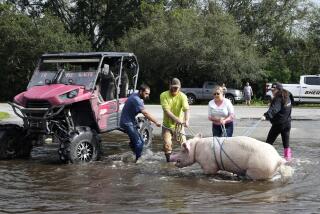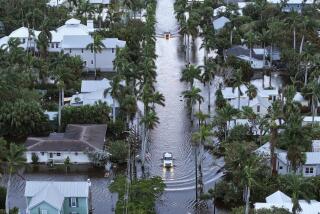Hurricane Isabel’s Surprising Punch
- Share via
BALTIMORE — Along the piers and cobblestone streets of Fells Point, the people living in the 150-year-old brick row houses that line the waterfront thought they had survived Hurricane Isabel in surprisingly good shape.
Then they got sucker-punched.
Hours after the storm had passed on to the northwest and high tide had brought only moderate flooding in the predawn hours of Friday, a new wall of water -- driven by southerly winds that trailed behind Isabel -- surged unexpectedly up Chesapeake Bay. Pouring into Baltimore Harbor as much as 8 feet above normal levels, it flooded the buildings so quickly that many residents could save little more than their lives.
The unexpected storm surge arrived with such speed that one resident described water rising neck-deep in his basement apartment. “My refrigerator was floating,” Eddie Hohman said. “That’s what woke me up yesterday morning, when it banged into the sink.”
Almost miraculously, no lives were lost, though Baltimore police and fire crews made dozens of waterborne rescues, according to Mayor Martin O’Malley. But in personal and financial terms, the losses were devastating to an area that had only recently begun to glimpse a bright future after decades of decline.
Hurricane Isabel, meantime, had worn itself out and all but vanished somewhere along the Canadian border far to the north, leaving behind a vast swath of damage and desolation as bad as or worse than what Fells Point experienced.
At least 27 deaths had been blamed on the storm, 16 of them in Virginia, the Associated Press reported.
An estimated 2.8 million houses and businesses remained without electricity from North Carolina’s Outer Banks north to New York, with full restoration of service a week or more away in many localities. Downed trees and flood debris blocked hundreds of roadways, slowing the repair work even as summery weather returned to much of the region.
Thousands of people boiled their drinking water, tried to cook perishable food before it spoiled from lack of refrigeration, and struggled on as best they could.
In Fells Point on Saturday, bright sunshine glittered on harbor waters that once more lapped gently against their embankments. People gathered on brick sidewalks and stone porch steps to recount their experiences, offer each other help, and try to salvage something from the sodden personal effects that described their lives.
A mile or so north of Baltimore’s Inner Harbor, Fells Point is a long-neglected area of early-19th century houses, aging piers and warehouses that only recently began to attract renovators, small businesses and tourists. Like Baltimore as a whole, it seemed to have risen on one knee, only to be knocked on its back again.
“It’s pathetic. You see people with their belongings out in the street,” said Peggy Vick, a Salvation Army worker operating a canteen truck in the neighborhood. “Oh, my goodness. They’ve got family portraits and keepsakes that have been destroyed, and personal photographs, and they’re trying to save them.”
It was a sad reminder that, even without loss of life, the receding floodwaters had left behind a coating of mud, oil and harbor waste that damaged almost everything it did not destroy.
“Disinfectant: That was the most important thing, the main thing we wanted,” said Gloria Weber, 70, outside her house on South Ann Street. She and relatives were wielding brooms and other cleaning supplies provided by the Salvation Army.
Visible down a narrow stairway, the refrigerator that had awakened Hohman lay against a pile of debris, tilted at a 30-degree angle. The only objects that seemed to have survived undamaged were his collection of bobblehead football players. They remained safely perched on a ledge just below the ceiling.
A circular saw and other electrical tools had been dragged up to the sidewalk on Thames Street for possible salvage. His living room furniture, dresser, desk and dining table had already been consigned to a dumpster. He spread books out to dry. At 23, Hohman could roll with the punch.
A neighbor, one of many yesterday morning who focused on what remained of family photo albums, found it harder to turn the page. As she sat outside her house peeling away wet photographs and spreading them in the sun, what she lamented was a loss of memories. “That’s my London years, man. My seven years in London,” she said.
Nancy Conrad, 65, an artist who specialized in oil paintings, seemed desolate as she stood outside a house that once seemed to hold her whole life.
Conrad was away when the storm surge struck. When she returned, the handsome floors, wide planks cut from the hearts of huge trees in the early 1800s, had warped so badly that she had to have someone break in the front door. Inside, she found only ruin.
“Everything on the first floor is lost. The upholstered furniture. The warped chest. The rugs, cushions, all the wet magazines, it’s just all gone,” she said. “All my old photos were in a box in a bottom drawer.”
John Lowe, manager of a waterfront hotel called the Admiral Fell Inn, said, “We used to have a very nice canopy but we saw it floating down the street.... The most surreal thing I saw was a car in the harbor and a sailboat floating in the street.”
The inn’s main kitchen -- including stoves, freezers, refrigerators and ovens -- was ruined, along with a pub and restaurant in the basement.
As a member of a budding neighborhood business community the city had counted on to feed its revival, Lowe was more fortunate than many. His inn is part of a chain. Commercial cleaning crews were already at work scouring the flood-stained areas.
And even before the water receded, Lowe had arranged for a fleet of amphibious vehicles called ducks to transport guests to the chain’s other hotels in the Baltimore area.
Nadine Gussio, owner of a waterfront shop, was not so fortunate. For her, the storm surge brought financial disaster.
Her shop, called the Frame House, specialized in picture framing, posters and gifts. Almost nothing escaped water damage, and she had nothing to fall back on.
“I’m sure it’s $100,000, and no flood insurance,” she said, holding back tears. “It’s not a pretty picture.”
Expecting high water from the hurricane, she had raised the merchandise a foot above the floor. But when she got to the shop, she said, it was flooded and a flock of mallards was paddling around the front door.
Many could not shake off losses that often had a uniquely personal dimension. For Doug Kolodny-Hirsch, a Fells Point resident, it was his car. His house escaped damage, but his beloved Acura was swept away -- one of several hundred cars lost in the neighborhood.
“I thought it was a safe location,” he said, “but that was based on precedent. We’ve never had a storm like this.”
“I loved that car,” he said yesterday. “I detailed it every weekend. I really loved that car.”
Salvation Army official Peggy Vick had a more immediate problem on her mind: dinner for 200.
Pleading with a colleague by cellphone, she argued for a little variety in the menu. “They’ve already had hot dogs on top of hot dogs,” she said, “What else do you have?”
Her lobbying worked. Saturday night, there were chicken breasts and veggies for all.
Staff writer Dick Cooper contributed to this report.
More to Read
Sign up for Essential California
The most important California stories and recommendations in your inbox every morning.
You may occasionally receive promotional content from the Los Angeles Times.










